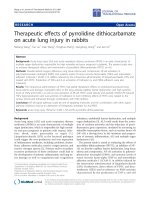Analyses of chemical composition on bacteria surface treated in atmospheric pressure plasmas
Bạn đang xem bản rút gọn của tài liệu. Xem và tải ngay bản đầy đủ của tài liệu tại đây (193.43 KB, 2 trang )
Analyses of Chemical Composition on Bacteria Surface Treated in
Atmospheric Pressure Plasmas
大気圧プラズマで処理した細菌表面における化学組成解析
Shohei Yoshida, Tadashi Fukuda, Kazuo Takahashi, Takuya Urayama*, Shinji Aoki**
吉田昇平,福田匡,高橋和生,浦山卓也*,青木慎二**
Department of Electronics, Kyoto Institute of Technology,
Matsugasaki, Sakyo-ku, Kyoto 606-8585, Japan
京都工芸繊維大学大学院工芸科学研究科電子システム工学専攻,〒606-8585 京都市左京区松ヶ崎
* Adtec Europe Ltd., London
**Adtec Plasma Technology Co.,Ltd, 6-10, 5-chome Hikino-cho, Fukuyama City, Hiroshima, 721-0942, Japan
(株)アドテックプラズマテクノロジー,〒721-0942 広島県福山市引野町五丁目6番10号
The sterilization mechanism was analyzed in atmospheric plasmas. It was confirmed that the cell wall of
G.stearothermophilus exposed to plasmas was elapsed observing with scanning electron microscope
(SEM). From the x-ray photoelectron spectroscopy (XPS) spectra, the content of -CH
2
-CH
2
- bond
decreased, and then the signal from O
1S
increased with plasma exposure. Analyses of SEM photographs
and XPS spectra would mean that the cell wall of bacteria was oxidized and damaged with plasma
exposure.
1. Introduction
We have been studied about sterilization
mechanism of bacteria, investigating the cellulose
and bacteria on paper strip exposed to plasmas.
Cellulose composed of pyranose rings was a model
material of peptidglycan corresponding to major
content of bacteria cell wall. Exposing plasmas to
cellulose caused pyranose rings to be opened and
ring chains to be cleaved (Fig. 1). The changes of
chemical bond composition in pyranose rings
correspond to damages of sugar chain on the
bacteria cell wall, which results in killing bacteria.
Besides we confirmed that it was possible to
sterilize bacteria on paper strip with in our
atmospheric plasmas setup.
In this study we observe bacteria
(G.stearothermophilu ATCC 7953) on Si substrate
coated by Au using scanning electron microscope
(SEM). For analysis of chemical composition on
bacteria surface we make use of x-ray photoelectron
spectroscopy (XPS) and evaluate how bacteria
Fig.1 Schematic for changing of pyranose ring structure.
surface changes by exposed to plasmas. In all
experiments, bacteria are treated with not only
plasmas but also heatgun to be investigated the
effect of heat from plasmas.
2. Experiment
Figure 2 shows the schematic of the experimental
setup. Atmospheric pressure plasmas were
generated by applying 2.45 GHz microwave power
to a metal rod as an antenna in the plasma torch. A
stub tuner was used for matching the microwave
power. Ar gas was introduced to the torch.
Samples of bacteria (G.stearothermophilus
ATCC 7953) on Si substrate deposited Au (55
mm
2
) was treated with Ar gas flow rate of 3.5 slm,
plasma exposure time of 10 min, distance from
antenna to sample of 10 mm, and microwave power
of 70 W. In order to investigate the effect of heat
from plasmas, we treated bacteria with heated air
flow (200°C) from heatgun in the experimental
conditions same as in case of plasmas.
The XPS was employed for chemical analyses on
bacteria surface. On the other hand, the effect of
plasma on sterilization was evaluated in observation
of bacteria using SEM. In addition, we measured
optical emission spectra of plasmas to investigate
the sterilization mechanism.
Opening of pyranose ring
Cleaving of pyranose ring chain
OH
N
2
Ar
O
2
Fig.2 Schematic of setup for atmospheric plasmas.
Fig.3 SEM photograph of bacteria.
3. Results and Discussions
3.1 SEM photograph of bacteria
Figure 3 shows bacteria exposed plasmas. The
bacterium of left side in Fig. 3 has an ellipsoidal
shape and looks like to be partly ruptured. One of
right side in Fig. 3 looks like to be destroyed
completely. Thus we can understand that burst of
cell wall or cell membrane happens in the Fig. 3.
The one treated with heatgun did not change in
SEM observation.
3.2 XPS spectra of bacteria
Figure 4 shows XPS spectra on the bacteria
surface. The original (pre-treatment) surface is
known to have several chemical bond components
of (-C(=O)-NH- or –O-C-O-), -C-OH, -CH
2
-CH
2
-,
and -C-C- (Fig. 4(a)), since the predominant
constituents of bacteria surface are hydrocarbon
followed by polysaccharides and peptides [1]. After
the plasma treatment, the chemical bond of
-CH
2
-CH
2
- disappeared on the surface (Fig. 4(b)). It
seems that hydrogen was disorbed from the cell
wall, and the wall was oxdized and damaged in the
plasma treatment. We could not find any changes in
the XPS spectra of bacteria treated with heatgun.
3.3 Optical emission spectrum
Figure 5 shows optical emission spectrum from
plasma discharge. The signals from OH, N
2
, and O
were obserbed as well as that from Ar. Several
species coming from atmospheric may be candidate
for reactants on the cell wall.
Fig.4 XPS spectra on the bacteria surface.
Fig.5 Optical emission spectrum in the plasma
(Ar: 7 slm, Power: 50 W).
4. Summary
We analysed the sterilization mechanism with
SEM photograph, XPS spectra of bacteria
(G.stearothermophilu), and Optical emission
spectrum of plasma. The cell wall of bacteria could
be ruptured by plasma exposure. The chemical
bond of -CH
2
-CH
2
- disappeared and O-content
increased. These cahnges in chemical bond
compositions corresponded to oxidization and
damages of the cell wall. On the other hand, the
effect of heat from plasmas did not related to
rupture of bacteria. In plasmas, several species of
excited Ar and those from atmosphere may be
candidate for the reactants of sterilization.
References
[1] Jess J. Ojeda, Mara E. Romero-Gonzlez, Robert G.
Edyvean, and Steven A Banwart ‘Characterization
of the Cell Surface and Cell Wall Chemistry of
Drinking Water Bacteria by Combining XPS, FTIR
Spectroscopy, Modeling, Potentiometric Titrations’
Langmuir 4032-4040, 24 (8) 2008
Ar
Plasma
Torch
Silica
Tube
Bacteria
2.45 GHz
Tuner









